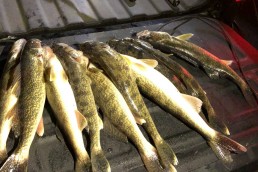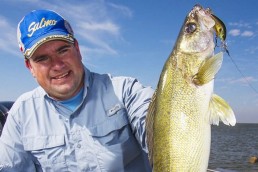Open-water, Early-season Transitions
SHARE THIS POST
From ice-out until the walleyes lock into their summer patterns, I find them in a constant state of transition. During certain times through this transitional period the bite can be outstanding or the walleyes’ moods and movements just might not be conducive to a good bite. Rest assured that once those walleyes move to mid-lake structure or suspend and establish some routines, fishing will become more predictable for this species.
I say you can always catch some fish. Here is how I go about fooling those early-season transitional walleyes.
From the post spawn until the fish begin relating to mid-lake structure, walleyes will be following schools of minnows that are up on the shallow sand flats or in the shallow vegetation. Find the forage and you will find the fish.
The technique for fishing shallow sand flats requires a moderately-fast approach to find fish, yet you want to provide a natural bait presentation. For this I use a Roach Rig with a heavier walking sinker and about 3 to 4 feet between the weight and the bait.
I’m not typically fishing this rig right under the boat. The line will be stretched out about 30 to 50 feet from the Lund at about a 45-degree angle. The water you will be fishing is typically 8 to 15 feet deep and as you S-troll the Roach Rig over the sand you will connect with the walleyes that are following the baitfish.
Keep the sinker on the bottom and when you do connect with a fish mark the spot and work the area. Those schools of minnows move around and so do the walleyes, and you often find yourself getting a few here and a few there when the fish are spread out on the flats.
Are you enjoying this post?
You can be among the first to get the latest info on where to go, what to use and how to use it!
During the early-season transition period walleyes can concentrate on a rubble point in 3 to 10 feet of water. This is a great spot to cast a jig and minnow. Use light line so you can really cast that jig a long distance and use a stand-up style jig head so when you’re dragging the lure back to the boat the tail of that minnow is sticking up off the bottom. The walleyes will inhale that jig as it slips past them.
Weed walleyes are often ignored all year long. Some might think there are no lakes in Canada with vegetation. That’s a mistake because there are plenty of lakes and even some moving water systems that have a lot of walleyes in the weeds during transitional periods and they will be feeding at that time.
Let’s start with bulrush walleyes. The water is real shallow around bulrush and walleyes move right up to the edge of this emergent vegetation to feed. The best way to get them to commit is to stick a small shiner minnow on a plain hook a foot or two below the surface under a bobber. Cast right up to the edge of the bulrush and give the minnow a little time to work its magic. Some guys like to anchor when they bobber fish. I let the wind dictate this situation. If it’s not so windy I can control the boat with an electric motor I leave the anchor stored. But I will drag out that heavy piece of iron to hold the boat if I think fish are there and I want to position a bait.
Another good place to find weed walleyes is on the edge of newly emerging submerged vegetation. A weedless jig tipped with a minnow is the ticket here. You just pitch the jig to the edge of the “vedge” and let it sink to the bottom. Don’t be in a hurry to get the jig back to the boat. Just drag it back slowly giving it an occasional hop. Just work that weedline until you find some hungry fish.
The one problem with walleyes during transition is that they tend to be shallower so the sonar is only good to give you a depth reading. To find walleyes during the transition you have to fish for them. You have to drag the Roach Rig over the flats, you have to bobber those shallows, you have to work that jig. You have to go after them with the lures and techniques that work best in this time of transition. I actually enjoy it when fish are shallow because I find I’m not glued to the sonar screen and can focus on the bite and have fun moving around working on my boat control.
Once the mid-season appears walleyes will work out into deeper water where the sonar becomes an important tool once again. For now just get out there and fish hard and you might find this early-season transitional period can provide some excellent fishing when adjusting your presentations to fit the program.
MWO
SHARE THIS POST
Did you enjoy this post?
You can be among the first to get the latest info on where to go, what to use and how to use it!
Gary Roach
MidWest Outdoors works with more than 200 outdoor experts each year, who contribute articles based on their areas of expertise. MidWest Outdoors magazine offers more fishing and hunting articles than any other publication!



